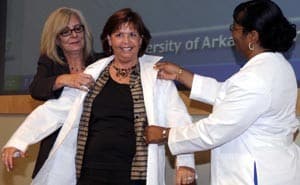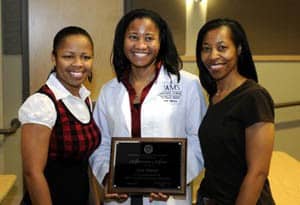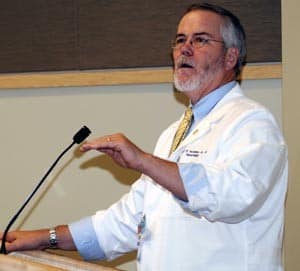UAMS Doctoral Candidates Receive White Coats
Oct. 7, 2009 | White coats were distributed to 32 University of Arkansas for Medical Sciences (UAMS) graduate students marking “the defining moment” of their young careers as a full house of mentors, faculty and family members watched. The students were celebrating the initiation of their dissertation research at the second annual Research Induction Ceremony for doctoral candidates held Sept. 28 at the I. Dodd Wilson Education Building Lecture Hall. “This is truly the defining moment in your lives,” said Robert McGehee Jr., Ph.D., dean of the UAMS Graduate School. “At this point all of the angst and sweat of your qualifying exams is behind you and you all know more now than you ever will the rest of your careers. It’s a pivotal point in your lives and that’s why we’re here to celebrate.” The students pursuing the Doctor of Philosophy degree all have successfully passed the Ph.D. qualifying exam and are now formal Ph.D. candidates. The ceremony represents an official transition from enrollment in coursework to the initiation of the dissertation research. Students will now set off on a career of discovery in biomedical and health research with the expectation that their work will lead to improvement in health and a better understanding of the human condition. The ceremony also marks a time when students have selected their mentor or major graduate advisor who assumes the role of mentor from the program’s graduate director. Students’ relationships with mentors being cultivated during this time is an important linkage, McGehee said. Galen Wenger, Ph.D., professor in the UAMS Department of Pharmacology and Toxicology, was the ceremony’s guest speaker. He detailed the evolution of the musical genius of Johann Sebastian Bach, who had many mentors in different parts of the world whose styles he mimicked and later made his own. “In scientific terms, he was building upon an existing database and ultimately discovered something he called his own,” Wenger said. “At this point in your studies, you understand the discoveries of those in your field and you will use that to create your own. The important thing is to not only make discoveries on your own, but to then pass them on.” Following the presentation of the white coats, the students and faculty joined to recite the “Affirmation of Scientists,” which publicly acknowledges the acceptance of the expected standards of honor and integrity. |


